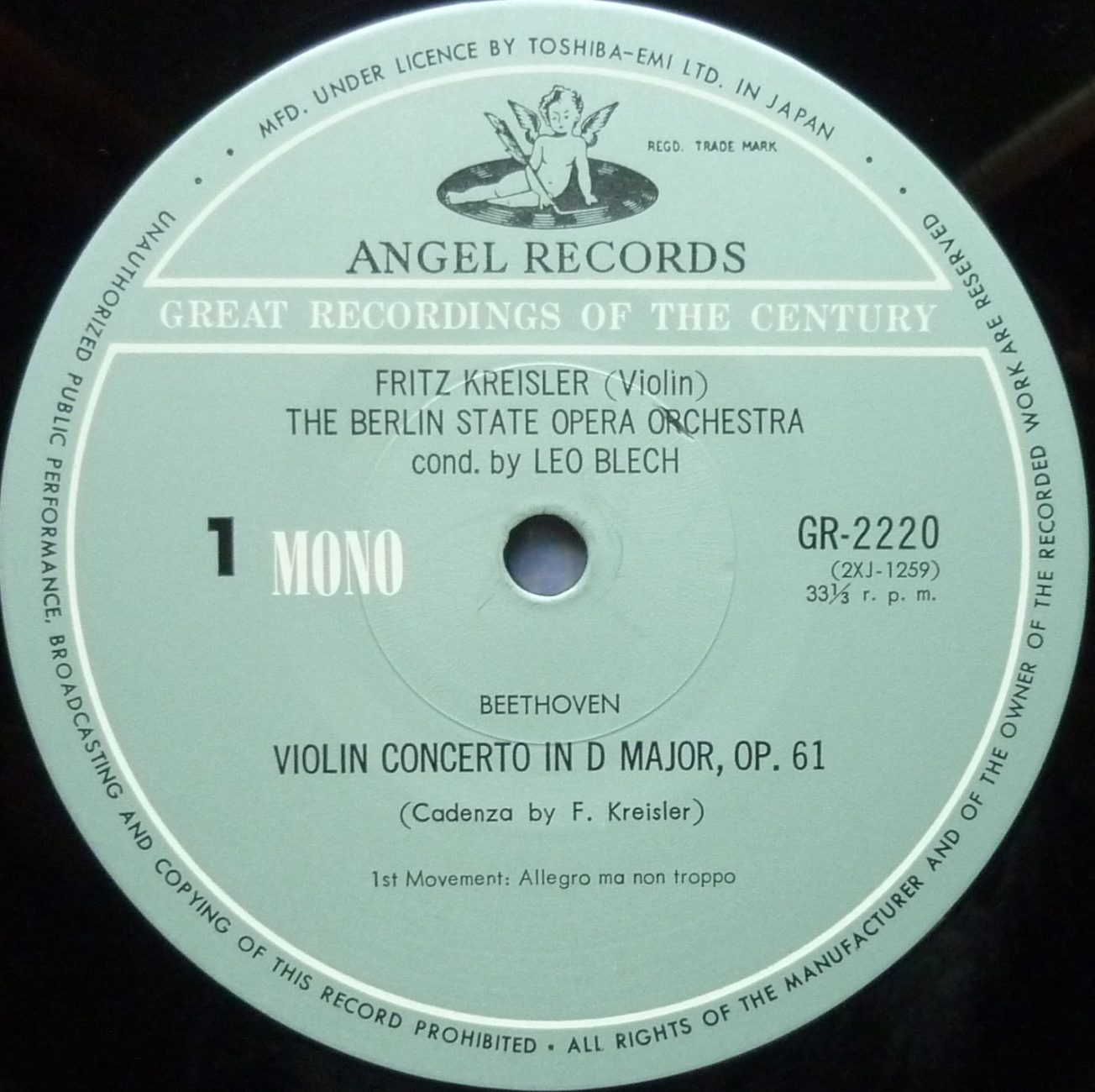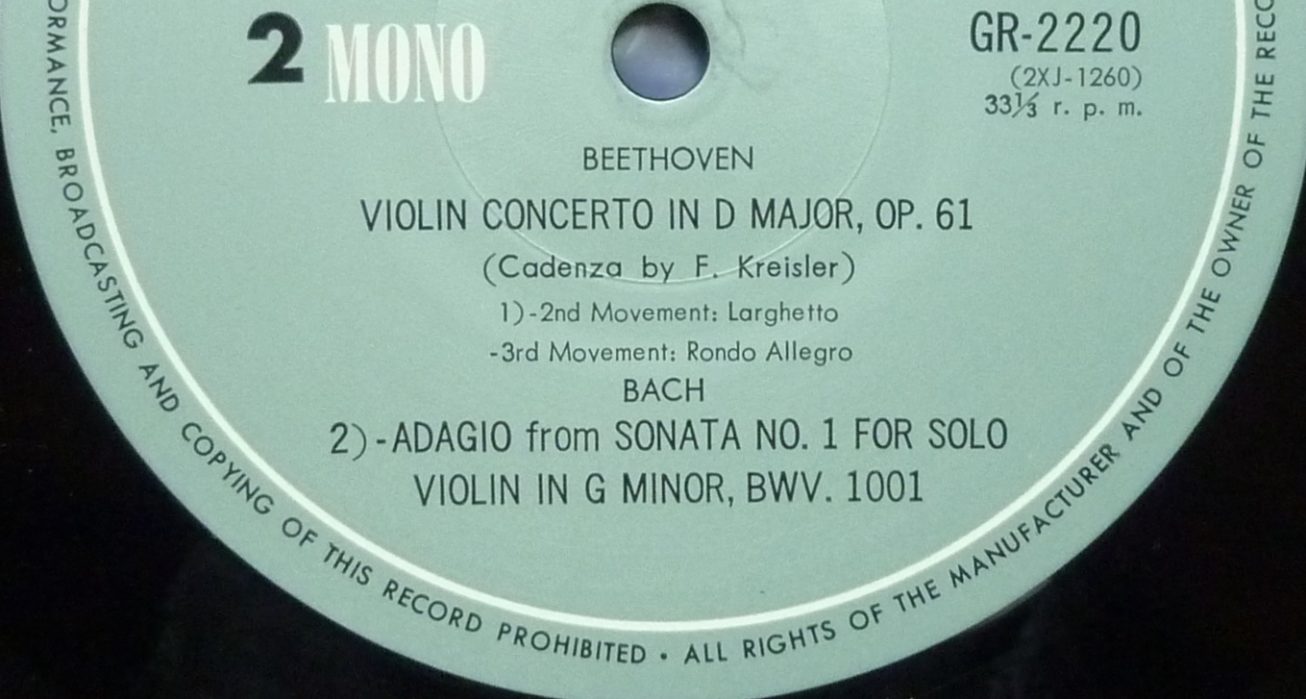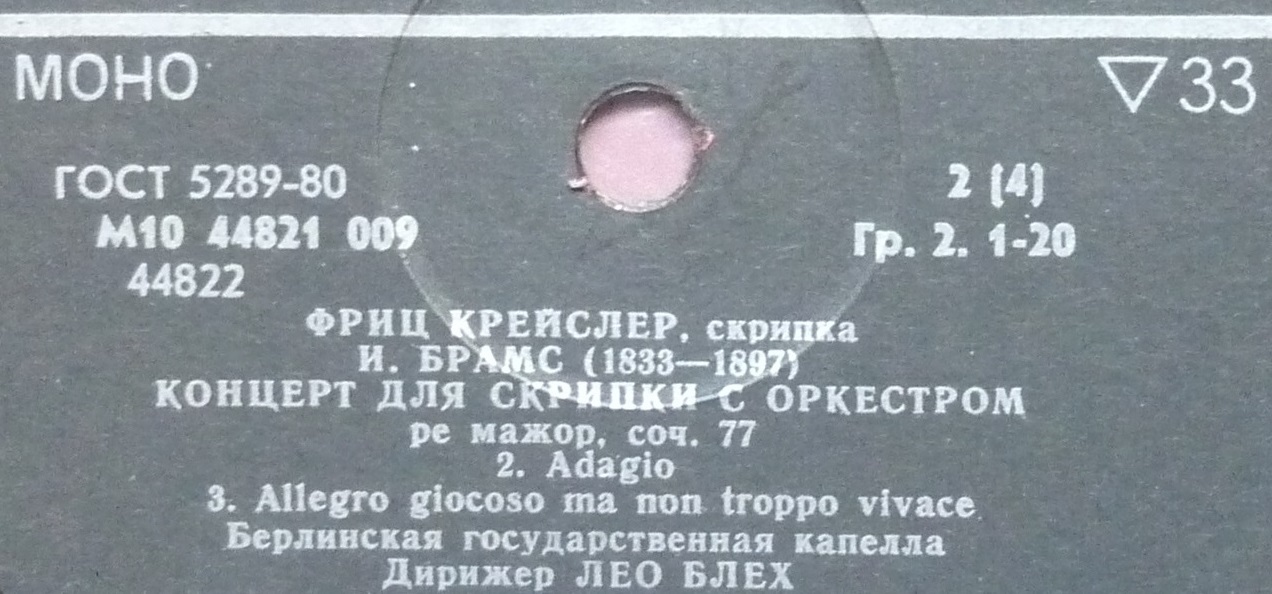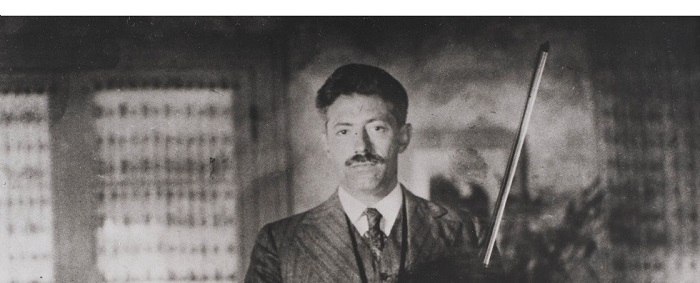Étiquette : Fritz Kreisler

Staatskapelle Berlin dir: Leo Blech – Berlin Singakademie
__________
Beethoven Concerto Op. 61
14 au 16 décembre 1926
DB990-995 – Matrices CWR 631-641 (Beethoven)
14 décembre: CWR 631 1A, CWR 632 2, CWR 633 1A; 15 décembre: CWR 636 3A, CWR 637 2A, CWR 638 2, CWR 639 3A;
16 décembre: CWR 634 4A, CWR 635 2, CWR 640 2, CWR 641 2A
Bonus: Bach Sonate n°1 BWV 1001 (Adagio) Fritz Kreisler: 16 décembre CWR 642
__________
Brahms Concerto Op. 77
21, 23 & 25 Novembre 1927
Beethoven: 33t. EMI-Toshiba (1971); Brahms: 33t. Melodiya
En décembre 1926, Leo Blech et Fritz Kreisler ont enregistré le Concerto de Mendelssohn Op.64 (les 9 & 10), puis du 14 au 16, le Concerto Op.61 de Beethoven.
Entre temps, le 12 et le 13, Kreisler a joué le Concerto Op.61 de Beethoven en public avec les Berliner Philharmoniker, cette fois sous la direction de Bruno Walter.
On ne saurait en déduire que le partenariat entre Blech et Kreisler qui a donné les enregistrements de ces trois grands Concertos était de pure circonstance. Si en effet le Concerto Op.77 de Brahms a été enregistré l’année suivante, il avaient déjà donné à Berlin une exécution de cette œuvre (avec le Concerto n°1 de Bruch) lors d’un concert des Berliner Philharmoniker en date du 9 décembre 1924.
En l’absence d’une liste des concerts de Leo Blech, notamment avec la Staatskapelle de Berlin (l’Orchestre du Staatsoper), ou de Fritz Kreisler, on ne peut dire si une collaboration régulière a existé entre eux et depuis quand. Leurs disques montrent en tout cas une entente d’une rare qualité1 .
En 1950, à l’occasion de son 75ème anniversaire, Kreisler a déclaré lors d’une cérémonie en son honneur:
« La musique est un art relativement indéfinissable. Juste un exemple: Comment un artiste peut-il arriver à une interprétation idéale de, disons, un Concerto ou une Sonate de Beethoven? Il n’existe pas de formule pour cela; nous n’avons pas de normes; nous n’avons pas d’exemples à consulter ou à copier; du moins, nous n’avons pas d’exemples universellement reconnus. De ce fait, tout artiste, en fonction de son tempérament et avec son intuition, doit concevoir et créer ses propres idéaux et les suivre dans l’espoir qu’un jour il pourra les atteindre…. Un artiste se rend compte très souvent que ses propres idéaux ont changé ou qu’il s’est beaucoup éloigné de son but. Il m’est arrivé une fois de penser que j’avais quasiment atteint mon propre idéal lors d’une exécution, mais il m’a fallu abandonner tout espoir de pouvoir y arriver de nouveau, car je me suis aperçu à quel point j’avais été aidé par des circonstances fortuites telle que mon état d’esprit, des conditions atmosphériques favorables et même les propriétés acoustiques de la salle où j’avais joué« .
La vie d’un artiste est un thème sur lequel on peut écrire beaucoup de variations ».
Bruno Walter, dont le livre de souvenirs est justement intitulé « Thème et Variations », a fait à cette occasion écho aux interrogations de Kreisler:
« Faire de la musique est pour Fritz Kreisler ce que voler est pour les oiseaux, ou nager pour les poissons. Et mon opinion est que c’est cette qualité élémentaire qui explique la magie qu’il exerce sur son auditoire, et qui transforme les événements éphémères de ses concerts en une expérience profonde et durable. Une heureuse étoile s’est mise à briller sur notre monde musical quand Fritz Kreisler y est apparu, quand il a pris son archet et son violon et a joué à pour l’oreille de plusieurs générations ses chants de beauté, de sérénité, de tristesse, de gaieté, de transfiguration et de bonheur ».
Kreisler avait sa propre conception de la technique (entrevue avec Samuel Applebaum):
« Pour la pratique instrumentale, on donne trop d’importance à la répétition physique, et pas assez au contrôle mental. La technique musculaire n’est pas seulement une question de développement musculaire, mais aussi d’implication mentale. J’ai souvent mémorisé un morceau de musique, parfois un Concerto important au cours d’un voyage en train. J’ai souvent joué des œuvres avec très peu de pratique préliminaire. Quand le Concerto d’Elgar m’a été dédié, je n’ai jamais mis un doigt sur la touche. Et puis, j’ai vu un passage que je pouvais améliorer et j’ai passé six heures dessus…. Je pratique seulement quand j’en ressens le besoin. C’est à la portée de beaucoup, s’ils développent leur cerveau depuis la prime enfance… Faire confiance à l’habitude musculaire, comme tellement de musiciens le font en matière de technique est en effet fatal. Un peu de fatigue, un peu de nervosité, un muscle perturbé et incapable de se contrôler et où êtes vous? Car la technique est vraiment un problème mental ».
1 Chacun de ces deux Concertos a bénéficié de trois jours d’enregistrement et le son est d’une qualité étonnante pour l’époque.
____________________

Fritz Kreisler Leo Blech BPO 9 décembre 1924 Bruch Concerto n°1 Brahms Concerto Op.77

Fritz Kreisler Bruno Walter BPO 12 & 13 décembre 1926 Beethoven Concerto Op.61
____________________
In December 1926, Leo Blech and Fritz Kreisler recorded Mendelssohn’s Concerto Op.64 (on 9th & 10th), then from the 14th to the 16th, Beethoven’s Concerto Op.61.
In between, on the 12th and the 13th, Kreisler performed the Beethoven’s Concerto Op.61 at concerts with the Berliner Philharmoniker, but conducted by Bruno Walter.
One should not draw therefrom the conclusion that the partnership between Blech and Kreisler that led to the recordings of these three great Concertos was purely a matter of circumstances. Whereas the Brahms Concerto Op.77 was recorded the following year, they gave a prior Berlin performance of this work (with Bruch’s Concerto n°1) during a concert of the Berliner Philharmoniker on December 9, 1924.
Without a list of the concerts given by Leo Blech, especially with the Berliner Staatskapelle (the Staatsoper Orchestra), or by Fritz Kreisler, it is not possible to tell whether a partnership existed between them on a regular basis and since when. However, their recordings testify to a rare understanding between them1.
In 1950, for his 75th birthday, Kreisler declared during a ceremony in his honour:
« Music is a rather indefinable art. For instance, to give you but an example: How can an artist achieve an ideal performance of, let us say, a Beethoven Concerto or a Sonata? There are no formulas for it; we have no norms; we have no examples which we could consult and copy; at least we have no universally acknowledged examples of it. Therefore, any artist, according to his temperament and through his intuition, has to conceive and create his own ideals and follow them in the hope that some day he may be able to attain it…. An artist very often realizes that his own ideals have changed or that he has receded further from his goal. I once, myself, thought I had come very near my own ideal in a certain performance,but I had to abandon all hopes of being able to repeat it, because I realized how much I had been aided by fortuitous circumstances, such as my disposition, favourable atmospheric conditions and even the acoustical properties of the hall in which I played.
The life of an artist is a theme on which many variations can be written ».
Bruno Walter, whose souvenir book is by the way titled « Theme and Variations », echoed Kreisler’s questions in a short address:
« To make music is for Fritz Kreisler what flying is for the birds, what swimming is for the fish. And I am of the opinion it is this elementary quality which explains the spell that he casts over his audiences, that changes the passing events of his concerts into a profound, lasting experience. So it was certainly a lucky star that shone upon our musical world when Fritz Kreisler appeared in it, when he took his bow and fiddle and played into the ears of generations his songs of beauty, of serenity, of sadness, of gaiety, of transfiguration and of happiness ».
Kreisler had his own way to technique (interview with Samuel Applebaum):
« Too much emphasis is being placed on physical repetition in practice, and not enough on mental control. Muscular technic is not a matter of muscular development alone, but of mental application. I have often memorized a piece of music, in some instances, an important Concerto while travelling on the train. I often played works with very little preliminary practice. When the Elgar Concerto was dedicated to me, I never put a finger on the fingerboard. Then I saw a passage I thought I could improve, and spent six hours on it…. I practice only when I feel the need. Many people are capable of doing this if they develop their minds from early youth… To rely on muscular habit, which so many do in technic, is indeed fatal. A little fatigue, a little nervousness, a muscle bewildered and unable to direct itself, and where are you? For technic is truly a matter of the brain ».
1 Each of these two Concertos was granted three recording days and the sound quality is astonishing for the period.




____________________
Les liens de téléchargement sont dans le premier commentaire. The download links are in the first comment.

1-3 Concerto pour violon et orchestre Op.64 – Staatskapelle Berlin 9&10 décembre 1926
4 Die Hebriden, Ouvertüre, Opus 26 – Berliner Philharmoniker (BPO) – 5 avril 1932
___________
London Symphony Orchestra (LSO):
5 Meeresstille und glückliche Fahrt, Opus 27 – Kingsway Hall 28 octobre 1931
6 Symphonie n°4, Opus 90 : IV. Saltarello: Presto – Kingsway Hall 27 octobre 1931
7 Lieder ohne Worte, Opus 62 n°6 & Opus 67 n°4 – Queen’s Hall 29 octobre 1931
___________
1-5 33t. Melodiya; 6-7 33t. Past Masters
Le violoniste Fritz Kreisler (1875-1962) a gravé beaucoup de disques, mais ses enregistrements les plus importants ont été réalisés dans les années vingt avec les Concerti de Beethoven, Brahms et Mendelssohn sous la direction de Leo Blech, et des Sonates de Schubert, Beethoven et Grieg avec Sergeï Rachmaninov au piano.
Le premier en date de ces enregistrements est le Concerto de Mendelssohn capté les 9 et 10 décembre 1926 à la Singakademie de Berlin avec la Staaskapelle de Berlin (l’Orchestre du Staatsoper). La qualité de la prise de son est vraiment étonnante, surtout en ce qui concerne le violon, tant du point de vue du timbre que de l’ampleur sonore. A l’époque, il jouait sur un Stradivarius de 1733 qui a été son instrument de 1908 à 1934, date à laquelle il fut acheté par Bronislaw Huberman, et il le remplaça par un autre « Strad », le « Lord Amherst of Hackney » de 1734 qu’il conservera jusqu’en 1946.
Dans le Concerto, Kreisler bénéficie du soutien orchestral apporté par Leo Blech que les autres enregistrements montrent comme un mendelssohnien hors pair. Dans les deux Ouvertures, il arrive à rendre aussi bien la légèreté et la fluidité du discours que sa tension dramatique. Le Final de la Symphonie « Italienne » est enfin un vrai Saltarello, joyeux et dansant d’un bout à l’autre. Quel dommage que l’on n’ait pas les trois autres mouvements!

Violonist Fritz Kreisler (1875-1962) has cut many discs, but his most important recordings have been made during the 20s with Concerti by Beethoven, Brahms and Mendelssohn conducted by Leo Blech, and Sonatas by Schubert, Beethoven and Grieg with Sergeï Rachmaninov at the piano.
The earliest of these recordings is Mendelssohn’s Concerto recorded on 9 and 10 December 1926 at the Singakademie of Berlin with the Staaskapelle Berlin (the Orchestra of the Staatsoper). The recorded sound is truly astonishing, especially for the violin, for both timbre and volume. He was then playing on a 1733 Stradivarius which was his instrument from 1908 to 1934, when it was bought by Bronislaw Huberman, and he replaced it by another « Strad », the 1934 « Lord Amherst of Hackney » he kept until 1946.
In the Concerto, Kreisler benefits from the orchestral support brought by Leo Blech whom the other recordings display as an outstanding Mendelssohn conductor. In both Overtures, he succeeds in rendering the lightness and the fluidity of the musical speech as well as its dramatic tension. The Final of the « Italian » Symphony is for one a true Saltarello, playful and dancing from beginning to end. What a pity he did not record the other three movements!
Les liens de téléchargement sont dans le premier commentaire. The download links are in the first comment.



